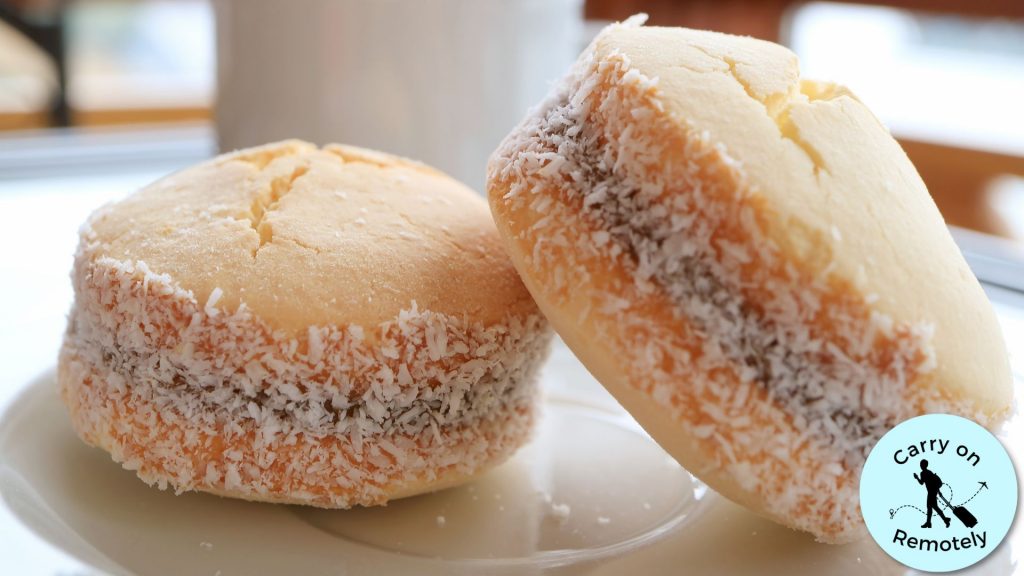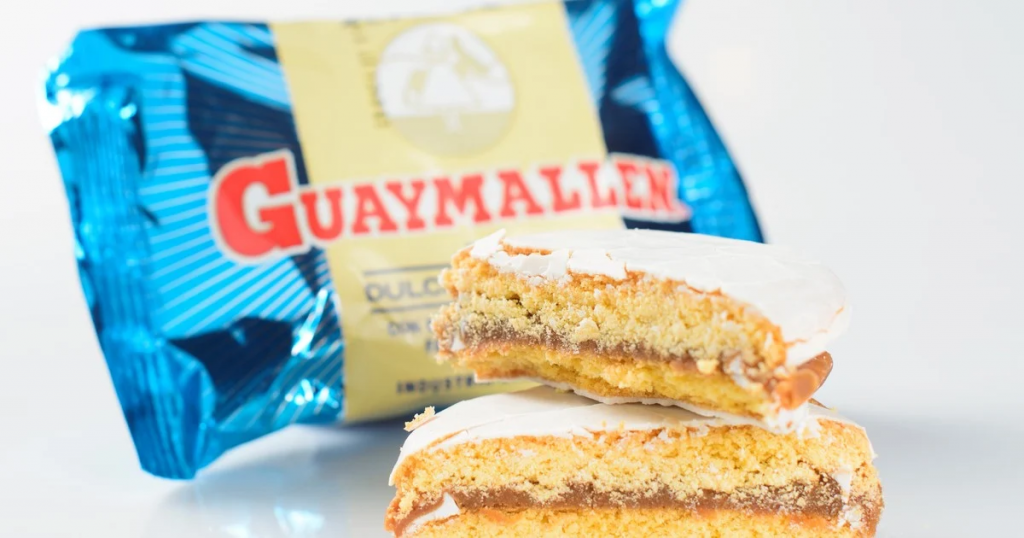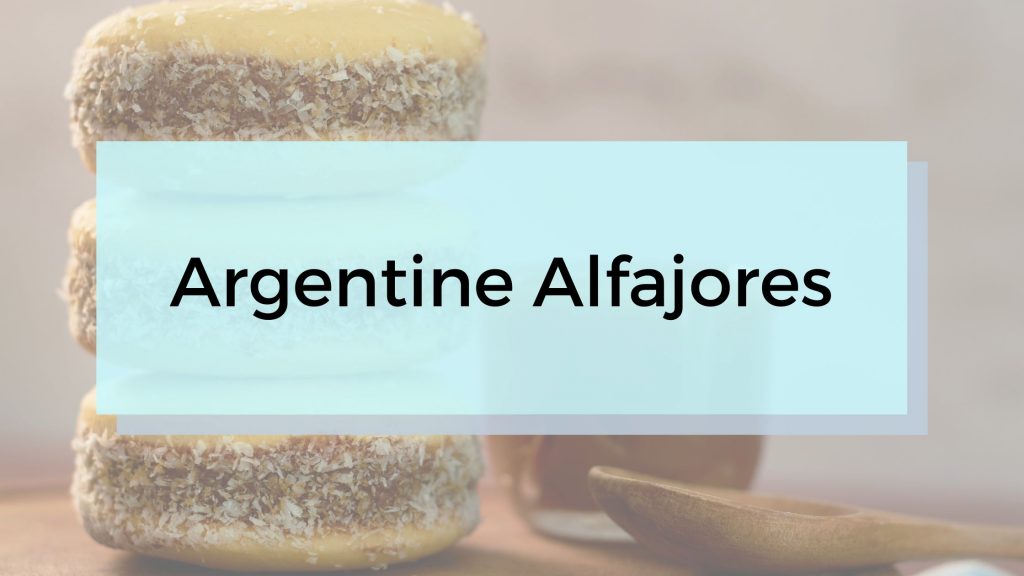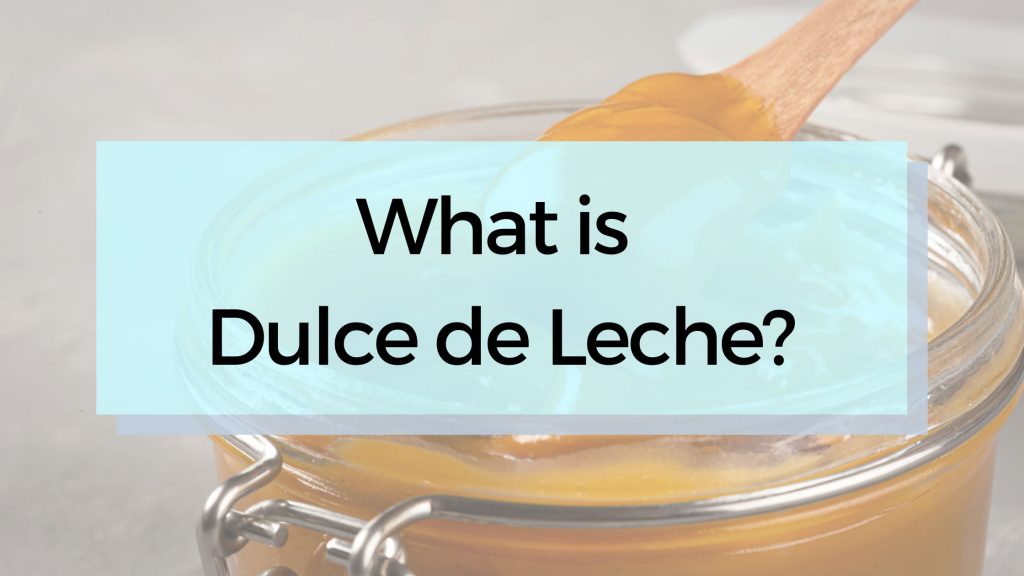Argentine alfajor is a sweet cake with two biscuits, caramel(called dulce de leche), and covered in chocolate. Nowadays there are different types, gluten free, jam instead of dulce de leche, covered in white chocolate, glazed or with seeds.
They are the traditional sweet snack for children and adults alike. They are perfect to have with a cup of tea or coffee.
Argentines love alfajores so much that in 2021, 6 million alfajores were sold per day, resulting in an annual projection for 2022 of 10.5 million per day, according to data provided by ADGYA (Asociación de Distribuidores de Golosinas, Galletitas y Afines).
What are alfajores de maicena?
Alfajores de maicena (cornstarch alfajores) are the most typical and popular in Argentina, they are made from corn starch biscuits, filled with dulce de leche and shredded coconut around.
Nowadays, in Argentina these sweets are on every children’s birthday table and at every gathering.

Where do alfajores come from?
The alfajor comes from the Andalusian dessert of the same name in the province of Huelva, Spain. There, alfajores are handmade, consisting of a dough of honey, almonds, breadcrumbs, cinnamon, cloves and matalahuva(anise).
They are usually sold wrapped in cellophane and their elaboration has been documented since the 18th century. But the Spaniards inherited it from the Arabs who were in those lands for 700 years and influenced all of Europe with many products. It was originally called “al-hasú” which in Arabic means stuffing.
The word mutated until it became what we know as alfajor and finally reached Argentina, where it combined Arabian cuisine with Mexican-American chocolate and Argentinean dulce de leche.
In Argentina, around 1851 in the town of Arocena, province of Santa Fe, Don Manuel Zampatti began to elaborate a variant of the already known alfajor.
It consisted of a sweet cake made up of three baked cookies, glued with dulce de leche and coated with sugar. It was the first alfajor known in Argentina, predecessor of the alfajor santafesino. Colonel Néstor Fernández took it to the battle of Caseros and it became so popular that General Justo José de Urquiza used to take it to his estancia San José de Entre Ríos.
Among the regional Argentinian alfajores are the Cordoba alfajores, filled with fruit jam (usually quince), the Santa Fe alfajores, made of no less than three flaky pastries glued together with lots of dulce de leche and the whole thing glazed and the Tucumán alfajores, also known as ‘clarita’, which is made with crunchy cookies and filled with caramel made with sugar cane honey.
As a mass-produced sweet cake, its production dates back to the 1950s in the Atlantic Coast. Brands such as Havanna and Balcarce were the pioneers, and later it was massively developed throughout the country. Statistics from 2004 indicate that 6 million alfajores are consumed in Argentina every day.
Spanish alfajores VS Argentine alfajores, what’s the difference?
Although alfajores came to Argentina from Spain, Argentine alfajores have nothing to do with Spanish alfajores, they are completely different sweets, so whether they come from the same history or not is irrelevant because they do not share neither ingredients nor appearance.
- Spanish alfajores are traditional Christmas sweets and are most commonly prepared in Andalusia and Murcia. Their main ingredient is almond paste, which is combined with honey and walnuts.
- Argentine alfajores consist of two or more cookies that are joined by a filling. Traditionally, the filling is usually dulce de leche, although we can find other flavors such as fruit filling or some kind of mousse. These alfajores may or may not be dipped in chocolate or icing.
What are alfajores made of?
The most typical alfajores are made of two biscuits with a dulce de leche filling. Then, they are covered in black chocolate.
Bakers and experts say that alfajores must have a good quality dulce de leche. The biscuits must be crunchy on the outside and tender on the inside, it’s very important not to overcook them. Lastly, the chocolate coating must be of good quality, so it should not be hydrogenated chocolate.
Best alfajores brands in Buenos Aires
In order to identify which are the best-selling alfajores, the UKRA (Unión de kiosqueros de la República Argentina) conducted an exclusive survey in which 112 thousand kiosks throughout the country participated.
These are the ten best selling alfajores in Argentina:
10. Capitán del espacio
Native of the south of the GBA, this alfajor has just turned 60 years old. The filling is abundant and the dough is tender. Its fans underline its very good price-quality ratio. A popular icon that became big without the need of marketing strategies. It is not easy to get it but it is worth the search.

9. Fantoche
Fantoche is the pioneer of triples. Since the release of its three-layer format, it has become a favorite. The formula is simple: chocolate dough and dulce de leche filling.

8. Bon o Bon
This alfajor is a derivative of the Bon o Bon bonbon, which has been so successful since its emergence in the 80’s, when it established another classic event of the kiosk business, the Week of Sweets (La Semana de la Dulzura during the first week of July). The alfajor is filled with marroc, which makes it different from the rest.

7. Jorgelín
This is also a pioneer of the three-layer format. Besides, it comes from an established family, it is a triple made of three layers of soft cookies, with two layers of dulce de leche plus a semi-bitter chocolate coating.

6. Terrabusi triple cake
From the Terrabusi family, this triple alfajor is distinguished by its texture. The dough is spongier and resembles a sponge cake.

5. Milka Oreo
Milka and Oreo – renowned brands in the food industry – have joined forces to launch a line of products, including this alfajor. It is a triple with two fillings: white, characteristic of the filled cookie, and dulce de leche.

4. Mini Eagle Cake
Another example of cake-type alfajores -where the dough is more moist and spongy- is this alfajor, which comes in several versions such as brownie or red fruits, although the most sold is the classic one: with cream and dulce de leche filling.

3. Tofi simple black
This alfajor was a triple premium but the brand Arcor decided to transform it into a simple version, launch it massively and bring it out to compete with the most accessible alfajores, explains Ernesto Acuña, member of UKRA, delegate of CABA.

2. Jorgito
Jorgito is considered, due to its quality, a popular premium. The glazed version has nothing to envy to those regional alfajores, which are sold by the dozen and cost much more expensive. However, it is the version with chocolate coating that sells the most in kiosks.

1. Guaymallén
Guaymallén’s alfajor is rich and cheap. This is the formula used by Guaymallén to maintain its leadership in sales compared to last year. The white chocolate version is the most loved by the Argentine public.

👉 My top three favourites:
Goulis
This company started in the 90’s and they have updated the typical Argentinean alfajor by making its filling of dulce de leche with a jam center, making Guolis one of a kind.

Cachafaz
Another favourite of mine, Cachafaz has a thicker and more intense chocolate layer, a denser and caramelized dulce de leche, and a cookie whose citric essence is more orange blossom water than lemon, in addition to its texture, so different from the traditional ones.

Havanna
Havanna is a chain of coffee shops specialized in alfajores and chocolates, of its own production and craftsmanship, considered an emblematic Argentine brand, it occupies a privileged place in the feeling of an entire country.
It currently has more than 270 coffee shops distributed throughout Latin America and Europe, being present in more than 12 countries.

Where can you buy alfajores in Buenos Aires?
You can buy alfajores in any kiosk, supermarket, small grocery stores and coffee shops, like Havanna. You can buy only one or you can get a box of 6 or 12.
Where can you buy alfajores online?
You can find alfajores in Amazon. Another online shop that specialises in Argentine products is Stockear.me, you can choose from a wide variety of alfajores and other products. Find the online shop here.
Other articles about food in Buenos Aires you might like:
50 Awesome Things To Do in Buenos Aires 2022 (Local Recommended)
As a couple from Buenos Aires and Dublin, we have combined our list of tourists’…
What is a typical Argentine breakfast?
One very important piece of information for tourists arriving in Argentina is that we don’t…
What is dulce de leche? Best dulce de leche in Buenos Aires
Visitors in Argentina always try foods with this delicious product but, what is it? In…
What is a BBQ called in Argentina?Our Parrilla and Asado Guide!
First of all lets discuss the word Parilla in Spanish. Parrilla refers to two things:…
What are alfajores in Argentina? Best alfajores
Argentine alfajor is a sweet cake with two biscuits, caramel(called dulce de leche), and covered…
What is mate drink in Argentina?
Drinking yerba mate is a very important social activity, similar to going to a café…






